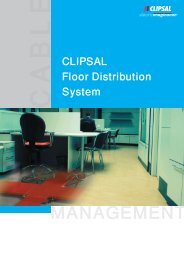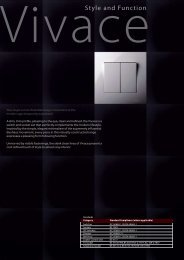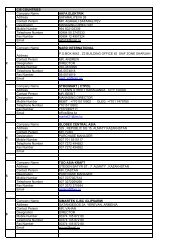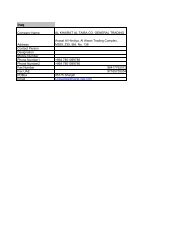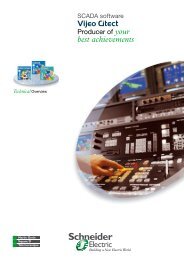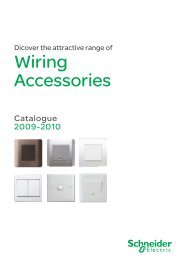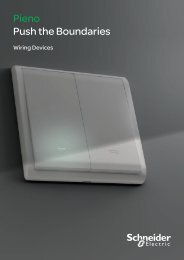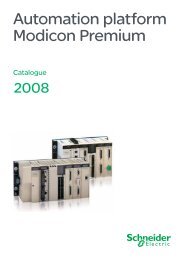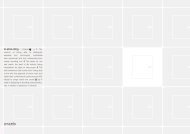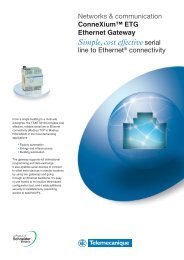Automation platform Modicon Premium - Schneider Electric
Automation platform Modicon Premium - Schneider Electric
Automation platform Modicon Premium - Schneider Electric
Create successful ePaper yourself
Turn your PDF publications into a flip-book with our unique Google optimized e-Paper software.
Memory structure (continued)<br />
Processor with mixed type memory card in slot no . 0 and data<br />
storage type memory card in slot no . 1 (1)<br />
Internal RAM<br />
PCMCIA card<br />
(slot no. 0)<br />
PCMCIA data<br />
storage card<br />
(slot no. 1)<br />
Presentation:<br />
page 1/4<br />
96 to 2048 Ko<br />
128 to 7168 Ko<br />
4096 or 8192 Ko<br />
(1) TSX P57 20 processors and higher<br />
Located data<br />
Global and DFB<br />
unlocated data<br />
Program and<br />
symbols<br />
Constants<br />
Additional data<br />
storage (zone A)<br />
Additional data<br />
storage (zone B)<br />
Description:<br />
pages 1/5 …<br />
1<br />
1<br />
2<br />
3<br />
4<br />
4<br />
<strong>Modicon</strong> <strong>Premium</strong><br />
automation <strong>platform</strong><br />
Unity processors<br />
Memory structure (continued)<br />
Extension of the data storage area<br />
Memory cards reserved for data storage (4096 or 8192 Kb) are used to:<br />
b Access the data storage area in cases where the application is fully loaded into the<br />
internal RAM. In this case, the data storage memory card is inserted into PCMCIA<br />
slot no. 0.<br />
b Free up memory to serve as additional program space when the application is on<br />
the PCMCIA card (slot no. 0). In this case, the data storage memory card is inserted<br />
into PCMCIA slot no. 1 (although the memory card in slot no. 0 can still be used for<br />
some of the data).<br />
Unity Pro programming software helps the application designer to manage the<br />
structure and organize how the memory space on the <strong>Premium</strong> PLC is occupied.<br />
Protecting the application<br />
Regardless of the PLC memory structure (whether the application is located in the<br />
internal RAM or on the PCMCIA card), it is possible to prevent the application from<br />
being accessed (for the purpose of reading or modifying the program) by only<br />
loading the executable code into the PLC.<br />
A memory protection bit, set in configuration mode, is also available to prevent any<br />
program modification (via the programming terminal or downloads).<br />
Program modification in online mode<br />
This function is different from previous versions of <strong>Premium</strong> PLCs (with PL7 software)<br />
in that it now allows program code and data from different parts of the application to<br />
be added or modified in a single modification session (thus making modification<br />
unified and consistent with regard to the controlled process).<br />
This increased flexibility comes at a cost in terms of the amount of program memory<br />
required. In order for the program to be modified in online mode, the amount of<br />
program memory space available must be at least equal to the combined size of all<br />
sections of the Unity Pro program affected by the single modification session<br />
concerned.<br />
Depending on circumstances:<br />
b In the case of a processor with a memory extension card, there will be sufficient<br />
memory left on the card for online modification, provided that the recommendations<br />
on page 1/22 are observed.<br />
b In the case of a processor without a memory extension card, if the user wants to<br />
be able to make modifications in online mode, he or she must select a processor on<br />
the basis of the following:<br />
v The anticipated size of the application<br />
v The number and size of the program sections to be modified in online mode<br />
Note: A memory extension card based exclusively on Flash EPROM technology (without<br />
additional SRAM) is clearly incapable of supporting online program modifications.<br />
Characteristics:<br />
pages 1/10 …<br />
References:<br />
pages 1/12 …<br />
PCMCIA references:<br />
pages 1/22 …<br />
1/9<br />
1<br />
2<br />
3<br />
4<br />
5<br />
6<br />
7<br />
8<br />
9<br />
10


